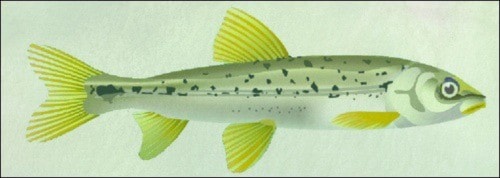SARAH DALZIEL
Boundary Creek Times Contributor
Conservation and reparation of habitat for the speckled dace was the focus of a meeting of the Kettle River Watershed Management team on Monday, Feb. 16.
About 20 people attended, from Westbridge and Beaverdell through to Grand Forks.
Speckled dace are in the minnow family, and as such are at the bottom of the fish food chain, and provide food for rainbow trout. They like clean gravels, and fast- owing water both shallow and deep.
The conservation plan is focused on three stretches of river, one on each of the three watershed river: the Kettle, West Kettle and Granby. Each stretch currently under consideration for conservation is over two kilometres long and contains all the types of habitat necessary for speckled dace survival. This includes overwintering and over summering zones, riffles, clean gravels and spawning areas.
The emphasis of the meeting was on river reparation, both for the purpose of conserving speckled dace, and in general of preserving the river itself as good fish habitat.
The first priority of reparation is reducing the in-flow of erosion and silt to the river. Erosion has a cumulative impact on the river, with forestry, agriculture, range use, roads, and urban development all contributing, in some measure, to erosion. The speckled dace require clean gravels, not embedded gravels. Embedded gravel is somewhat necessary for other species, like the native fresh water mussel.
Reparation is largely done through building up stream banks to prevent erosion, and the gradual building up of gravel bars to narrow, deepen and speed up the river. While bank reparation is fairly straightforward, prevent future erosion and mitigate current erosion swiftly. River reparation is more complex, and the impact of actions must be thoroughly studied before the reparation is actually undertaken.
Building up stream banks is most often done through planting native species. Usually willow, cottonwood or red osier dogwood, roots will firm the soil, slow the water, and encourage silt and gravel to remain on the bank instead of entering the river system.
When using riparian methods on gravel bars, willow is usually planted so that it will bend with the stream and slow it down. The slight slowing of the water, usually only impacted when it is in freshet, causes gravel and silt to drop out and thus build the bar.
Over time, as other debris are caught in the riparian zone, the bar changes from gravel into the new bank of a narrower, cleaner and swifter flowing river.
After discussing the ecology of the speckled dace and the riparian methods and possibilities, those present looked over the three rivers and pointed out some potential work zones.
The expressed goal for this year is doing riparian work on six zones, two on each river.
However, the larger plan is that the speckled dace conservation will be a long term project, and with back-up project zones planned and waiting to happen as the funding comes in.
Further, the higher upstream the riparian can happen, the better the downstream conditions will become. Stopping erosion at, or close to, the source is the main way to preserve the necessary habitat for this vital fish.
If the speckled dace are thriving, the other species in the river will be thriving too. Dace and rainbow trout are the keystone species for our river system, if they thrive then the other species will likely be thriving with them also.
If you would like to learn more about the speckled dace project, or are interested in becoming involved in helping with creating riparian zones, contact Graham Watt of the Kettle River Watershed Project.
Graham Watt is project coordinator of the Kettle River Watershed Management Plan, Regional District of Kootenay Boundary. Ask Watt watershed questions at plan@kettleriver.ca
